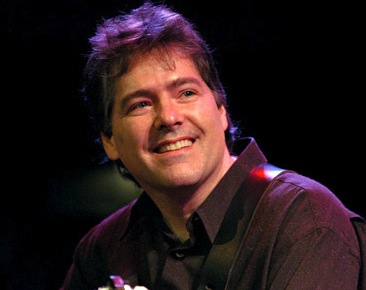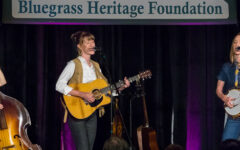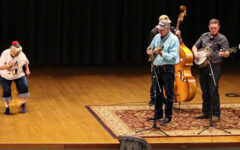
This interview with Béla Fleck was conducted by fellow banjoist Jake Schepps, who will review the Concerto based on Saturday’s performance. Jake’s latest CD, An Evening In The Village, also places the banjo in a classical setting, drawing on the music of Béla Bartok.
 The incredibly busy and prolific Béla Fleck premiers his Concerto for Banjo in just 2 days. For those that follow Béla on Twitter (@belafleckbanjo), he has been working hard over the last year to write and learn this piece, which was commissioned by the Nashville Symphony. It will be conducted by their music director Giancarlo Guerrero, and performed with the Nashville Symphony which received the 2011 ASCAP award for Programming of Contemporary Music. The Concerto is dedicated to Earl Scruggs, “whose innovative three-finger style set bluegrass music on fire in the 1940s.”
The incredibly busy and prolific Béla Fleck premiers his Concerto for Banjo in just 2 days. For those that follow Béla on Twitter (@belafleckbanjo), he has been working hard over the last year to write and learn this piece, which was commissioned by the Nashville Symphony. It will be conducted by their music director Giancarlo Guerrero, and performed with the Nashville Symphony which received the 2011 ASCAP award for Programming of Contemporary Music. The Concerto is dedicated to Earl Scruggs, “whose innovative three-finger style set bluegrass music on fire in the 1940s.”
The opening night performance (9/22) will be recorded for an album and filmed for DVD.
For those unfamiliar, a “concerto” is a musical work usually composed in three movements, in which (typically) one solo instrument (for instance, a piano, violin, cello, flute, mandolin or banjo) is accompanied by an orchestra. Traditionally, the three movements are fast-slow-fast, yet Béla describes these three as, “peppy, moody and hyper.”
In addition to solo banjo, the Concerto for Banjo is scored for piccolo, 2 flutes, 2 oboes, English horn, 2 clarinets, bass clarinet, 2 bassoons, contrabassoon, 4 horns, 3 trumpets, 3 trombones, tuba, timpani, percussion and strings. The program also includes Aaron Copland’s ever popular Appalachian Spring and Tchaikovsky’s Fourth Symphony (which set a new standard in composing for cymbals…..for real).
This week I got to ask Béla a few questions about the piece:
What should we expect?
“This is music I have worked on for nearly a year. It features the banjo heavily, but it also hopes to be enjoyed for the music itself, not just a vehicle for the banjo. It was a chance for me to really think hard about every single note, and try not to do things I have done before.”
What is the hardest part of the piece technically on the banjo? What about Orchestrally?
“This concerto is full of finger-busting stuff that I have had to play again and again to get down. For the orchestra there is the unfamiliarity of playing a piece generated by a banjo player’s brain. Also a lot of time changes, and held dissonances, that have to be played just right.”
Are there cadenzas? Are the cadenzas improvised? (a cadenza is an improvised or written-out ornamental passage played by a soloist)
“There are several solo cadenzas. If I get brave, there will be one improvised one.”
Given your technical expertise and experience with so much different music, you have a very large idea for what is idiomatic for the banjo. Therefore during this composition process, did you try to make it more idiomatic for the instrument? Are there places that was not the case?
“I did try to make it idiomatic as possible. I thought I had made it pretty natural, until I started really practicing it, and found it was a bear to play! I also tried to do things based on the notes, and not based on difficulty level.”
Can you describe your process for embarking on writing long form composition?
“I started by writing a bunch of small themes, and then I looked for the connectivity between them. That got me moving.”
Can you talk about how your progression from the double concerto with Edgar to the triple concerto, and now to a solo concerto? How did this progression affect the composition?
“In each case, I learned an immense amount from Edgar (and then Zakir Hussein). At a certain point I started wondering what I would come up with without such strong partners. And there were times when I might have tried a totally different approach, but I wasn’t strong enough conceptually to lead. So this time I got to try my own ideas and follow them through, and then rewrite them till I liked what I had.
That was much harder for me to do in a collaboration, especially since I don’t read and write standard notation very well.”
When we spoke last year at Swallow Hill, you said you were listening to Mozart’s Jupiter Symphony. Can you describe what you found compelling in piece, and what else did you listen to along the way?
“That is a very exciting piece. I also fell for Bartók piano and violin concertos, and Brahms piano concertos, Barber, Beethoven, and the list goes on.”
The program notes are available online which include more details about Béla and the concerto. Tickets and more information are available online as well, and the Thursday World Premiere will be offered as a free webcast from the NSO site starting at 8:00 p.m. EDT.
Here is a video created by Nashville Arts Magazine where Béla previews some of the themes from his Concerto.
http://www.youtube.com/watch?v=SX676NLWeil






